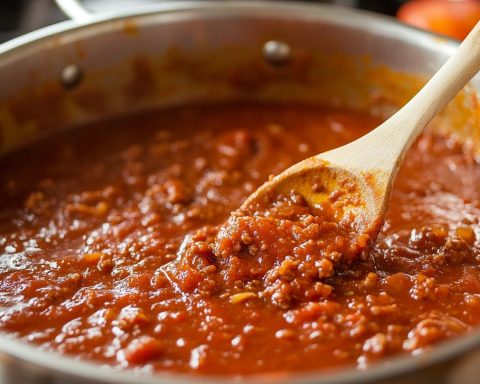Żurek, a beloved Polish soup, invites you into a world enriched by history and tradition. This dish, which has been a staple in Polish kitchens for centuries, resonates with stories of family gatherings and celebrations that bridge generations. Its distinctive, lightly sour flavor comes from fermented rye flour, making it not only a delight for the taste buds but also a treat for gut health enthusiasts seeking natural probiotics. Traditionally served in a bread bowl or with a side of crusty rye, żurek is perfect for cozy family dinners, festive Easter breakfasts, or any occasion that calls for warmth and togetherness. As you embark on the journey to create this comforting soup, let it transport you to the bustling marketplaces and homey kitchens of Poland.
Ingredients:
Fermented Rye Starter (Zakwas):
– 1 cup rye flour
– 2 cups lukewarm water
– 2 cloves garlic, peeled
– 2-3 bay leaves
– 5 allspice berries
– 1-2 slices crusty rye bread (optional, for fermentation)
For the Soup:
– 1 lb smoked Polish sausage (kiełbasa)
– 1 lb boneless pork rib or bacon chunks
– 1 large carrot, peeled and chopped
– 1 medium onion, peeled and halved
– 1 parsnip, peeled and chopped
– 2-3 potatoes, peeled and cubed
– 4-5 cups of water or chicken stock
– 1 tbsp marjoram, dried
– 3-4 cloves garlic, minced
– Salt and pepper to taste
– 2 tbsp sour cream
– Fresh dill, for garnish
– Hard-boiled eggs, for serving
Instructions:
1. Prepare the Zakwas (Fermented Starter):
In a clean jar, combine 1 cup rye flour with 2 cups lukewarm water, stirring until smooth. Add 2 cloves of garlic, 2-3 bay leaves, and 5 allspice berries. If desired, place 1-2 slices of rye bread atop the mix to boost fermentation. Cover the jar with a cloth and leave it at room temperature to ferment for 3-5 days, stirring daily. The starter signals readiness when it emits a tangy, slightly yeasty aroma.
2. Cook the Meat and Vegetables:
In a large pot, boil the smoked Polish sausage and boneless pork ribs (or bacon) in 4-5 cups of water or chicken stock. Skim off any foam that forms. After 20-25 minutes, add the chopped carrot, onion, parsnip, and potatoes. Season with a pinch of salt and pepper, cooking until the vegetables become tender.
3. Blend the Soups’ Tangy Base:
Remove the sausage and ribs from the broth. Dice the sausage and shred the meat. Return the meat to the pot. Stir in your prepared zakwas, adding it gradually until the desired tangy flavor is achieved. Sprinkle 1 tbsp of marjoram for aromatic earthiness.
4. Final Touches:
Simmer for an additional 15 minutes to let the flavors meld. Incorporate the minced garlic towards the end to retain its pungency. Just before serving, stir in 2 tbsp of sour cream to smoothen the tang. Balance with salt and pepper.
5. Serving Suggestions:
Ladle your golden, fragrant żurek into bowls or hollowed-out bread. Garnish with sprigs of fresh dill for added freshness. Top each bowl with halves of hard-boiled eggs for extra richness. Serve warm, if desired, with a side of extra crusty rye bread for dipping.
Cooking Tips:
– For a deeper flavor, let the zakwas ferment in a cool, dark space longer, up to 7 days.
– Always adjust the sourness by tasting as you stir in the zakwas; some prefer it subtly tangy, while others opt for a robust sour note.
Pairing Ideas:
Enjoy żurek with a chilled glass of Polish beer or a crisp, dry white wine to complement its rich, savory profile. This combination not only elevates your meal but also pays homage to the robust flavors of Polish cuisine.
Let żurek be your vessel to connect with the warmth and spirited traditions of Poland, where every bowl is a story shared among family and friends.
Unraveling Żurek: The Polish Soup with a Controversial Past
Żurek, the beloved Polish soup, is not just another comforting dish; it has a rich history peppered with controversies and intriguing secrets. This hearty soup, traditionally served during Easter, has also waded through tales of social class divisions and fascinating culinary debates.
A Soup with Controversy: Did you know that in certain periods of Poland’s history, żurek was emblematic of social class? It was primarily consumed by the working class and often considered a ‘poor man’s dish’ due to its simple ingredients and low cost. However, over time, it has transcended these boundaries, becoming a staple at festive occasions and family gatherings.
Fermentation’s Hidden Secrets: The fermented rye starter (zakwas) is key to żurek’s unique flavor profile. Interestingly, not all Polish regions prepare żurek the same way. Some areas incorporate additional herbs or even sour cream directly into the zakwas before fermentation, making regional variants a topic of debate among food purists.
Health or Hearty? While celebrated for its probiotic benefits, there is a debate among health enthusiasts: does the long cooking process of żurek diminish its gut health benefits? The answer is nuanced. While some probiotics may not survive the heat, the soup’s creamy consistency and high fiber content still offer substantial nutritional value.
Intriguingly, żurek has also become a popular choice in fine dining restaurants seeking to elevate traditional dishes with gourmet twists, such as incorporating truffle oil or wild game meats.
Whether you’re a culinary expert or a home cook, exploring żurek’s diverse interpretations can be a journey of both taste and tradition.








